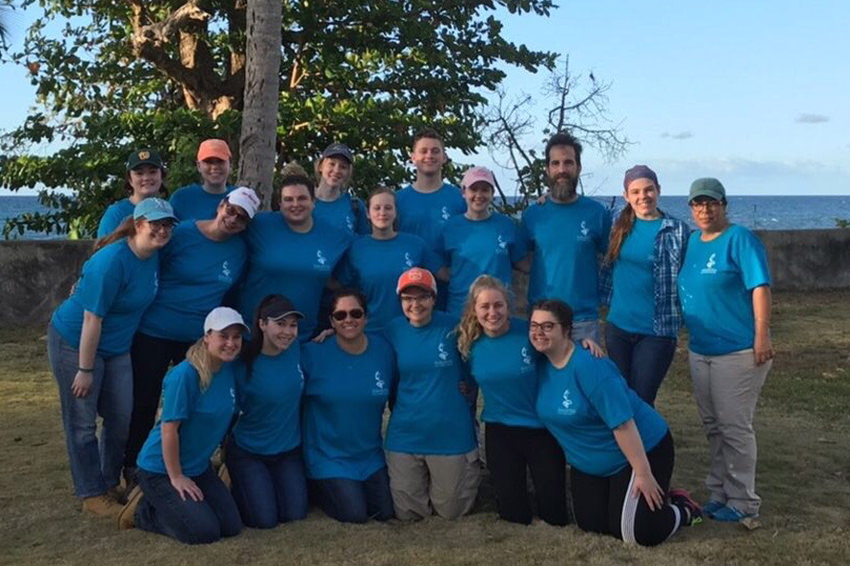Hurricane-relief trip combines learning with hands-on aid
Trip made possible by endowed professorship award

By Samantha Sharp
Students got to see firsthand how disaster relief operates in a weeklong service-learning trip to Puerto Rico during spring break.
Dr. Tim Brackenbury, the M. Neil Browne Professor in communication sciences and disorders (CDIS), led a team of 14 undergraduate students and two faculty members, Drs. Mary-Jon Ludy and Virginia Dubasik, from the College of Health and Human Services (HHS) to San Juan to help with hurricane relief efforts. The trip was made possible in large part due to funding from Brackenbury’s endowed professorship award.
The primary goal of the trip was to learn about and assist a community that had been impacted by the 2017 hurricanes. The secondary goal was to meet with professionals from local universities and community members to discuss how they worked together and addressed different lingering aspects of the hurricanes’ devastation.
Brackenbury said that the planning for the trip started last fall semester.
“I met eight of the students in class last fall, and we spent that semester learning about Puerto Rico, hurricanes, and relief and response programs,” he said. “We concentrated on how those different groups work together and toward different goals.”
A wide variety of college majors were represented, including students in the honors program, criminal justice, public health, food and nutrition, CDIS, biology, finance and international studies. Food and nutrition major Lisa Langhals, a nontraditional student, discovered information about the trip in an HHS newsletter.
Langhals said it was interesting to learn how the Puerto Rican students’ curriculum had been adapted to fit the circumstances they were in. She found that the dietetic internship program at the University of Puerto Rico came up with “My Hurricane Plate” as a substitute for the well-known “My Plate” food group guide.
“Consider for a moment what your plate would look like without electricity, with very limited access to food. How would you feed yourself and your family? After one day without electricity, everything in your refrigerator and freezers has gone bad,” Langhals said. “Some went for several months without electricity, and there are still some issues with the electricity.”
Prior to the trip, Brackenbury met with the Center for Community and Civic Engagement to discuss community-based research, where the goal is to find people with whom to serve and work.
“Fundraising is fine, but developing programs and building relationships creates literal outcomes,” Brackenbury said. “When we are done with this project, things should be better in some way for these people, whether that’s more money coming in or new ideas.”
In addition to meeting with representatives from two separate Puerto Rican Universities, the BGSU students were split into four groups and assigned daily tasks. These included painting, roofing, window replacements and general construction work. Langhals’ group worked on a house that was badly damaged by the hurricane.
“The house owner was very grateful,” Langhals said. “Every day he made us this wonderful coffee as a way of saying thanks. During our work week, we removed and replaced windows, built door frames and hung doors, replaced a toilet and sink, cut tile, mixed concrete and used so many different power tools that I don’t know the names of.”
During the week, students were expected to keep a journal on their experiences and reflections. Brackenbury is planning to assign a final reflection paper for trip participants enrolled in his spring class that is connected to the trip and analyzes different models of disaster relief.
Langhals said that one of the biggest takeaways was the importance of meeting a client where they are in regard to their personal situation. Brackenbury seconded this, emphasizing that they wanted to help in ways that the client needed, not what they personally thought the client would need.
“You can read about natural disasters in the articles or in books and you can analyze different recovery models and look at different recovery plans,” Langhals said. “It all looks good on paper, but to actually go there and be a part of the recovery, be a part of the rebuilding, to make it just a little better for someone who has suffered so much loss, that’s a learning opportunity that becomes a part of you. Something you will never forget.”
Updated: 04/26/2019 03:33PM
